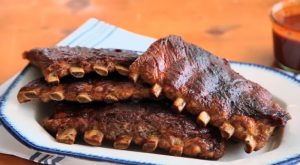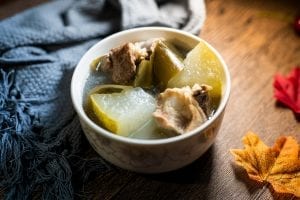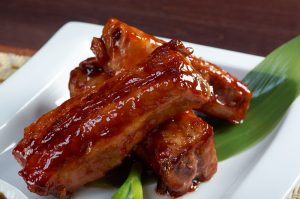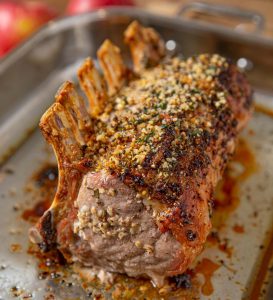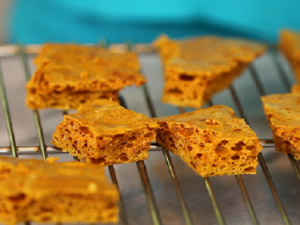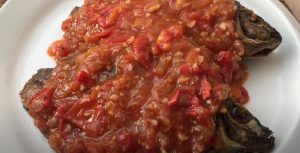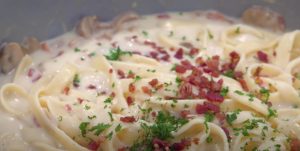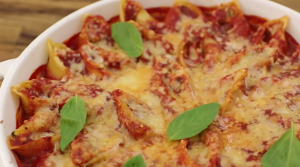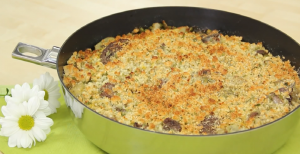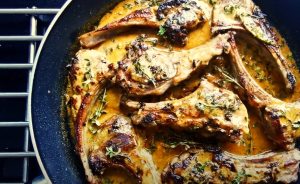Delight your taste buds with this savory one-pot Chinese ribs recipe. Succulent pork ribs are seared to perfection, then simmered in a pot with a blend of traditional Chinese flavors until they're meltingly tender. The result is a rich, flavorful dish that's surprisingly easy to make, perfect for a weeknight dinner or a special occasion.
The key ingredients in this recipe are pork ribs, cooking wine, rice vinegar, soy sauce, and garlic. Some of these ingredients, such as cooking wine and rice vinegar, may not be staples in your pantry, but they're readily available in most supermarkets or Asian grocery stores. The cooking wine adds depth of flavor to the dish, while the rice vinegar lends a subtle tanginess that balances out the richness of the ribs.
Ingredients for One-Pot Chinese Ribs
Oil: Used to sear the pork ribs, it helps to lock in the juices and gives the ribs a nice, brown crust.
Pork rib: The star of this dish, pork ribs are chosen for their perfect balance of meat and fat.
Cooking wine: Adds a layer of complexity to the dish and helps to tenderize the ribs.
Rice vinegar: Its mild acidity helps to balance the flavors.
Sugar: Adds a hint of sweetness to the dish.
Soy sauce: Gives the dish its savory, umami flavor.
Water: Used to braise the ribs, allowing them to become tender and flavorful.
Garlic: Enhances the flavor profile of the dish.
One reader, Christy Crocker says:





This one-pot Chinese ribs recipe is a game-changer! The flavors are rich and the meat is incredibly tender. The best part is the minimal effort required to make this delicious dish. It's a definite winner for busy weeknights or when you're craving some comforting Chinese flavors. Highly recommended!
Key Techniques for Making One-Pot Chinese Ribs
How to sear the ribs: Heat the oil in a large saucepan over medium heat. Add the ribs and sear until all sides turn golden brown.
How to simmer the ribs: Add in all the seasoning, bring the liquid to a boil, then reduce the heat and cover. Simmer the ribs for an hour to 90 minutes until they become really tender.
How to reduce the sauce: Once the ribs are cooked, remove the lid and reduce the sauce for 5 minutes.
How To Make One-pot Chinese Ribs
Have a tender and flavorful Chinese ribs dish by combining soy sauce and vinegar with the pork rib and slow-cooked for the meat to absorb that savory taste.
Serves:
Ingredients
- 1tbspoil
- 1⅓lbpork rib
For Seasoning:
- 1tbspcooking wine
- 2tbsprice vinegar
- 3tbspsugar
- 4tbspsoy sauce
- 5tbspwater
- 6clovesgarlic
Instructions
-
Heat the oil in a large sauce pan over a medium heat.
-
Add the ribs and sear until all sides turn golden brown.
-
Add in all the seasoning.
-
Bring the liquid to a boil, reduce heat, and cover. Simmer the ribs for an hour to 90 minutes. Until the ribs become really tender.
-
Once the ribs are cooked remove lid and reduce the sauce for 5 minutes.
-
Serve drizzled with sauce.
-
Enjoy!
Nutrition
- Calories: 1008.75kcal
- Fat: 77.99g
- Saturated Fat: 23.31g
- Trans Fat: 0.70g
- Monounsaturated Fat: 30.29g
- Polyunsaturated Fat: 14.03g
- Carbohydrates: 23.76g
- Fiber: 0.45g
- Sugar: 19.05g
- Protein: 49.99g
- Cholesterol: 241.92mg
- Sodium: 2051.58mg
- Calcium: 75.05mg
- Potassium: 914.14mg
- Iron: 3.41mg
- Vitamin C: 2.81mg
Crucial Technique Tip for Perfect One-Pot Chinese Ribs
When searing the pork ribs, make sure to not overcrowd the pan. Overcrowding can cause the ribs to steam instead of sear, preventing that desirable golden brown crust from forming. Also, using a pair of tongs can make turning the ribs easier and safer, reducing the risk of oil splatters.
Time-Saving Tips for Preparing This Recipe
Prep ahead: Chop and marinate the ribs the night before to save time on the day of cooking.
Use a pressure cooker: Consider using a pressure cooker to significantly reduce the cooking time for the ribs.
Multi-task: While the ribs are simmering, use that time to prepare side dishes or set the table to maximize efficiency.
Invest in pre-cut ribs: Save time by purchasing pre-cut ribs from the butcher or grocery store to skip the preparation step.
Organize ingredients: Before starting, organize all the ingredients and utensils to streamline the cooking process.
Quick cleanup: Clean as you go to minimize the post-cooking cleanup time and maintain an organized kitchen.
Substitute Ingredients For One-Pot Chinese Ribs Recipe
oil - Substitute with vegetable oil: Vegetable oil is a neutral-flavored oil that can be used as a substitute for regular oil in most recipes, including this one-pot Chinese ribs recipe.
pork rib - Substitute with beef short ribs: Beef short ribs can be used as a substitute for pork ribs, providing a rich and flavorful alternative in this recipe.
cooking wine - Substitute with chicken or vegetable broth: Chicken or vegetable broth can be used as a non-alcoholic substitute for cooking wine, adding depth of flavor to the dish.
rice vinegar - Substitute with apple cider vinegar: Apple cider vinegar can be used as a substitute for rice vinegar, offering a slightly fruity and tangy flavor to the recipe.
sugar - Substitute with honey: Honey can be used as a natural sweetener instead of sugar, adding a different depth of sweetness to the dish.
soy sauce - Substitute with tamari: Tamari, a gluten-free soy sauce alternative, can be used as a substitute for soy sauce, providing a similar umami flavor to the dish.
garlic - Substitute with garlic powder: Garlic powder can be used as a substitute for fresh garlic, providing a convenient alternative with a slightly milder flavor.
Best Way to Present One-Pot Chinese Ribs
Elevate the plating: Arrange the tender pork ribs in a visually appealing manner, ensuring they are the focal point of the dish. Use clean lines and minimalistic design to showcase the succulent ribs.
Incorporate vibrant colors: Introduce pops of color to the plate with garnishes such as fresh cilantro and thinly sliced red chili peppers. This will add visual interest and enhance the overall presentation.
Utilize negative space: Embrace the concept of negative space to create a sense of balance and sophistication on the plate. Allow the ribs to shine amidst carefully placed elements, such as steamed bok choy and baby corn.
Emphasize texture: Introduce contrasting textures by incorporating a crispy element, such as crispy shallots, to complement the tender and succulent nature of the pork ribs. This will add depth to the overall dining experience.
Artful drizzling: Skillfully drizzle the reduced sauce over the ribs, using a delicate hand to create an artful and enticing presentation. The sauce should be evenly distributed, enhancing the visual appeal of the dish.
Elevate with edible flowers: Introduce a touch of elegance by adorning the dish with edible flowers, such as chive blossoms, to add a sophisticated and luxurious touch to the presentation.
Attention to plateware: Select elegant and refined plateware that complements the colors and textures of the dish, enhancing the overall dining experience for the esteemed culinary professionals.
Essential Tools for Making Chinese Ribs in One Pot
- Saucepan: A deep cooking vessel with a handle and often a lid, used for cooking a variety of dishes such as soups, sauces, and stews.
- Tongs: A versatile kitchen tool used for gripping and lifting hot food items, such as the ribs in this recipe, without piercing them.
- Spatula: A flat, flexible utensil used for flipping and serving the ribs, ensuring they are handled with care.
- Knife: A sharp cutting tool used for trimming and preparing the pork ribs before cooking.
- Measuring cups and spoons: Essential for accurately measuring and adding the various seasonings and liquids to the recipe.
- Lid: A cover for the saucepan used to trap heat and moisture while simmering the ribs, aiding in the cooking process.
- Stove: The cooking appliance used to heat the saucepan and cook the ribs to perfection.
Storing and Freezing Leftover Chinese Ribs
- Let the ribs cool completely before storing or freezing.
- For storing in the refrigerator, place the cooled ribs and sauce in an airtight container. They will keep well for up to 4 days in the fridge.
- To freeze the ribs:
- Place the cooled ribs and sauce in a freezer-safe container or freezer bag.
- If using a container, make sure to leave some space at the top for expansion during freezing.
- If using a freezer bag, remove as much air as possible before sealing to prevent freezer burn.
- Label the container or bag with the date and contents.
- Freeze for up to 3 months for best quality.
- To reheat frozen ribs:
- Thaw the ribs overnight in the refrigerator.
- Place the thawed ribs and sauce in a covered pot or slow cooker.
- Heat on low until the ribs are heated through and the sauce is simmering. This should take about 30-45 minutes, depending on the quantity.
- Alternatively, you can reheat the ribs in the microwave. Place the thawed ribs and sauce in a microwave-safe dish, cover with a damp paper towel, and heat in 1-2 minute intervals, stirring in between, until heated through.
- Note: Reheated ribs may have a slightly different texture compared to freshly cooked ones, but they will still be delicious and full of flavor.
How To Reheat Leftover Chinese Ribs
- Reheat the ribs in a covered pot on the stove over low heat until warmed through, stirring occasionally to prevent sticking. This method helps retain the moisture and flavor of the sauce.
- Place the ribs and sauce in a microwave-safe dish, cover with a damp paper towel, and microwave on medium power in 30-second intervals until heated through. Stir between intervals to ensure even heating.
- Preheat the oven to 350°F (175°C). Transfer the ribs and sauce to an oven-safe dish, cover with foil, and bake for 15-20 minutes or until heated through. Remove the foil for the last 5 minutes to allow the sauce to thicken slightly.
- For a crispy exterior, reheat the ribs on a foil-lined baking sheet in a preheated 400°F (200°C) oven for 10-15 minutes, brushing with reserved sauce halfway through. This method works best if you have stored the ribs and sauce separately.
- If you have a sous vide machine, place the ribs and sauce in a vacuum-sealed bag and reheat in a water bath set to 140°F (60°C) for 30-45 minutes. This method ensures even heating and maintains the original texture of the ribs.
Interesting Fact About Chinese Ribs
The Chinese ribs recipe is a popular dish in Chinese cuisine. It is often prepared using traditional Chinese seasonings such as soy sauce, rice vinegar, and cooking wine. The slow simmering process allows the flavors to infuse into the tender pork ribs, creating a delicious and savory dish. This dish is often enjoyed as a main course and is perfect for family gatherings or special occasions.
Is Making Chinese Ribs at Home Cost-Effective?
This Chinese ribs recipe is highly cost-effective for a household. The use of affordable ingredients like pork ribs, garlic, and basic pantry staples keeps the cost low. The dish offers a delightful balance of flavors and textures, making it a satisfying and economical choice. The approximate cost for a household of 4 people is around $15-$20, making it a budget-friendly option. Overall Verdict: 9/10
Is This Chinese Ribs Recipe Healthy or Unhealthy?
This one-pot Chinese ribs recipe, while delicious, is not particularly healthy. Here's why:
- The recipe uses a significant amount of sugar and soy sauce, which are high in calories and sodium, respectively. Excessive consumption of these ingredients can lead to health issues like obesity, diabetes, and high blood pressure.
- Pork ribs are naturally high in fat, particularly saturated fat, which can contribute to heart disease and other health problems when consumed in excess.
- The recipe lacks vegetables or other nutrient-dense ingredients that could balance out the meal and provide essential vitamins and minerals.
However, with a few tweaks, this recipe can be made healthier without sacrificing flavor:
- Reduce the amount of sugar and soy sauce used in the seasoning mix, and consider replacing some of the soy sauce with low-sodium alternatives or natural flavorings like ginger or five-spice powder.
- Trim excess fat from the pork ribs before cooking to reduce the overall fat content of the dish.
- Add some vegetables to the pot, such as sliced carrots, bell peppers, or bok choy, to increase the nutrient density of the meal and provide a more balanced flavor profile.
- Serve the ribs with a side of steamed brown rice or quinoa instead of white rice, as these whole grains offer more fiber, vitamins, and minerals.
- Use a leaner cut of pork, such as pork loin or tenderloin, which has less saturated fat compared to ribs.
Editor's Opinion on This One-Pot Chinese Ribs Recipe
This one-pot Chinese ribs recipe is a delightful combination of sweet and savory flavors. The cooking method ensures that the ribs are tender and succulent, while the seasoning infuses them with a rich umami taste. The use of garlic, soy sauce, and rice vinegar adds depth to the dish, creating a truly satisfying meal. The simplicity of the one-pot cooking process makes it a convenient and impressive dish to prepare. It's a perfect choice for a cozy dinner at home or a gathering with friends. Enjoy the delightful flavors and tender texture of these Chinese ribs!
Enhance Your One-Pot Chinese Ribs Recipe with These Unique Side Dishes:
Similar Recipes to Try If You Enjoy One-Pot Chinese Ribs
Appetizer and Dessert Pairings for One-Pot Chinese Ribs
Why trust this One-Pot Chinese Ribs Recipe:
This recipe guarantees tender, succulent pork ribs infused with the rich flavors of cooking wine, rice vinegar, sugar, and soy sauce. The slow simmering process allows the ribs to absorb the aromatic garlic and the savory essence of the seasonings. The result is a mouthwatering dish that will surely impress your taste buds. Trust the expertise behind this one-pot Chinese ribs recipe, and savor the delightful blend of flavors in every bite.
Was this page helpful?
Have your own special recipe to share? Submit Your Recipe Today!




